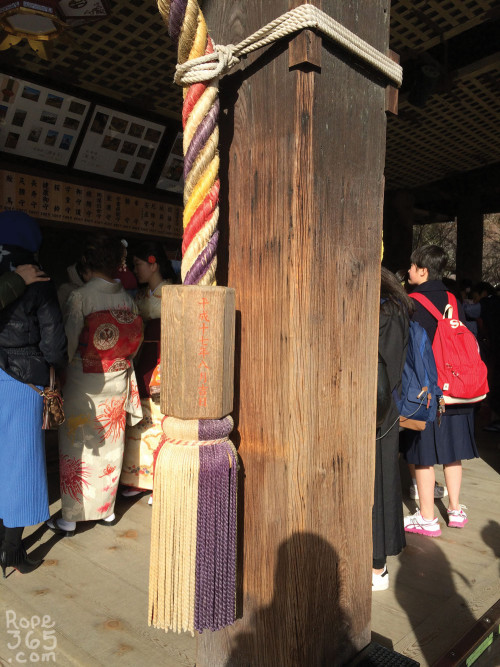Day 49: Colour
What colour fits your vibe? Choosing between the natural colour of the fibre or the flashy colour will bring a different mood from the start. Some ropemakers will go extra length to make custom colours, create ropes with several colours on it, or spin strands of different colours to create unique effects. What makes you pick a rope of a certain colour versus another? Is it a conscious choice?
Meaning of Colours
Many symbols and superstitions give meaning to different colours, and choosing a rope colour may be more than just an aesthetic decision for you.
Several Japanese historic documents mention the meaning of rope colour in hojōjutsu, the codification changed depending on region and time period. In the Meiji period, different rope colours were used depending on the type of prisoners. Purple for high rank and upper class, blue for the worst crimes, white for minor offences while black and red was used for lower-class people.
Earlier in history, each colour was associated with a season, element, direction etc. Blue was spring, east and wood; Red was summer, south and fire, white was autumn, west and metal; black was winter, north and water; yellow was midsummer, center and earth. To respect the symbology, the prisoner had to face a specific direction depending on the season and rope colour.
In the late Edo period, rope colour was used to identify the different police forces. Some Japanese police uniforms still showcase a piece of rope today, and the colour matches their prefecture.
Most cultures give different meanings to colours. Purple has been associated with royalty all over the world because it used to be a very expensive colour to dye. In Japan, it is the colour of the emperor and aristocrats.
We keep on giving new meaning to colours. Many people from the queer community will like rainbow ropes to represent the pride flag. Others will like pink or purple rope to feel more girly, which is interesting because these colours used to be associated with young boys not so long ago.
It is interesting to research in your own culture what colours mean. Do you feel more traditional and keep the rope with its natural colour? Or is there a colour you that will mean something important to you that you can bring to your rope practice?
Five strands rope in Kiyomizu-dera 清水寺 temple, Kyoto, Japan.
Dyeing Rope
If you feel crafty, you can try creating your own colourful rope. How to dye your rope will highly depend on the type of rope you have and the desired effect.
The first step is to find a dye that will match the material of your rope. Using products for dyeing clothing is a good place to start, check the type of fibre it can be used on. Most dyes made for natural fibres are unlikely to not work on synthetic fibres and vice versa. If your rope has a mixed material construction, you might have mixed results with the dye only working on some part of the rope (ex: cotton rope with a nylon core, a jute rope reinforced with synthetic fibre).
If your rope is not white to start with, you will have to take the initial colour into account. Bleaching your rope might help but it will also drastically weaken your rope. Going for a darker more saturated colour will make it easier to overpower the natural colour of the rope.
Every dye is different, follow the instructions on the package. Most techniques will involve getting the rope wet. You might want to dry your rope under tension afterward. Once again, this is especially important for jute rope.
Once the rope is freshly dyed, you might want to test that the colour doesn’t transfer on skin or clothing. This is a common problem when a rope is saturated with dye. Washing the rope and using it will progressively reduce this issue, and the rope will progressively fade with time.
Depending on the rope construction and the type of dye, it might be difficult to reach the core of the rope. This is usually not a big issue as we don’t generally look at the middle of the rope but it might cause the colour to fade faster. If you are spinning your own rope, you can work around this problem by dyeing the rope plies before assembling them.
As you get more comfortable with the technique of dying rope, you can use more complex techniques to create different effects. Create an ombre effect on the rope by putting some part of the rope in the dye for a longer period of time. You can also create a multicolour rope by bathing different parts of the rope in different colours, or spinning different strand colours together.
Practice Time!
Gather ropes of different colours and explore with them. If you feel crafty, get some cheap rope try different combination of bleach and dyes on the rope to make your own creation.
Exploration ideas:
- Which colours have special meaning to you or your partner?
- How does rope react when using bleach on it?
- Use dye to colour different rope materials.
- Can you create new effects on your ropes by bathing it in different colours or progressively adding it to the dye?
Inspirations and Resources
- Erin Houdini’s Nylon Rope Dyeing Guide!
- Tub Dyeing Basics by Fiber Reactive Dyes
- My rope (hemp rope dyeing guide) by Lillerkins
- All about hand dyeing by Paula Burch
- Dyeing rope video by Two Knotty Boys
Credit: R/P: Ebi McKnotty
Or return to The Rope for more options.


Leave a Reply